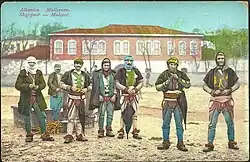| Part of a series on |
| Albanian tribes |
|---|
 |
The Macure were an Albanian tribe that lived on the territory on the part of Montenegro which is today known as Šekular.[1] Bratonožići and Rovci.[2] Like other non-Slavic tribes of Montenegro, they were either assimilated or expelled. The majority of scholars consider them to have been of Albanian origin. Today, their name is preserved in local Serbian legends and myths, while their name is sometimes used in Montenegro as derogative.
Origin
Milan Šufflay was the first to set the hypothesis that Macure were of Albanian origin, like Mataguži, Maine, Malonšići and Bukumiri.[3] This hypothesis about Macure was accepted by many other authors, including Pantelić.[4] Vladimir Ćorović presented a hypothesis that one of the possibilities is that Macure are related to Albanian Macarke or Macreke.[5]
Jovan Erdeljanović believed they were of Vlach origin whose name was derived from some Roman word which basis was mazz.[6]
Etymology
Macure might be related to the Montenegrin word maca meaning large hammer but it is used also to describe very strong as this word is used even today by people in Montenegro to describe a strong man by saying Jak ko maca! or Maca od čo'jeka. Also, it is common to find Montenegrin words that are of Slavic roots and end with "ure", for example Ljušture (meaning multiple layers), and Đevojčure ( plural: girls). This might indicate origin of name Macure is as to say multiple of strong people.
History
Like all other non-Slavic tribes of Montenegro, Macure were also completely assimilated or expelled by Slavs.[7][8] Macure became a derogative term in Montenegro, which is the case with names of other conquered and expelled tribes of Lužani, Bukumiri, Mataruge and others.[9]
With Ottoman incursion into Serbian Despotovina and Zeta, Macure, Mataruge and Kriči migrated in two directions. The first was across Eastern Bosnia and Central Bosnia, into Western and North Western Bosnia. The second was across Herzegovina and Dalmatia.[10]
Legacy
Macure are commemorated in Serbian legends and myths. According to Serbian legends, they were tall and strong people.[11] The Serb legends say that they saw snow for the first time when they came to Sinjajevina in Montenegro and made a snowball to bring it back to show it to their friends which soon melt in their hands.[12]
According to Erdeljanović, the toponym Macur-jama in Piperi territory has its origin in the name of the Macure tribe.[13]
A word Macurovine (transl. meadow), a first name Macur (recorded in 1575) and a surname Macura (recorded since 17th century) is derived from the name of the Macure tribe.[14]
References
- ↑ (Пантелић 1983, p. 65)
- ↑ Revue d'etnologie. Etnološko društvo Jugoslavije. 1986.
- ↑ Simpozijum seoski dani Sretena Vukosavljevića. Opštinska zajednica obrazovanja. 1992.
- ↑ (Пантелић 1983, p. 64)
- ↑ Ćorović, Vladimir (1933). Историја Југославије. Народно дело. p. 25.
Мацуре потсећају на арбанашке Мацарке или Мацреке, а можда су и неко наше племе са севера из области Мазура.
- ↑ Glasnik Zemaljskog muzeja u Bosni i Hercegovini. Zemaljska štamparija. 1934. p. 175.
Др. Ј. Ердељановић налази за ово племе да је оно свакако било старосједилачко (влашког) поријекла и да можда није имало сталног станишта, него да је живјело покретљивим но- мадским животом. За име Мацура сматра највјероватније да је постало од ...
- ↑ (Cvijić 1987, p. 175)
- ↑ (Đurić 1972, p. 156): "Потпуно су асимиловани или прогнани остаци неких група, као што су Матаруге, Мацуре, Муго- ши, Кричкови, Ћићи и прави Власи, који се често помињу као имена братстава и племена. Поред њих још и Шпањи, најстарији ..."
- ↑ (Popović & Skerlić 1937, p. 623): "...у Црној Гори погрдним односно презривим именима имена побеђених и истиснутих племена Лужана, Букумира, Матаруга, Мацура и др."
- ↑ Bulletin du Musée de la République Socialiste de Bosnie-Herzégovine à Sarajevo: Ethnologie. Sarajevski grafički zavod. 1962. p. 7.
... prema zapadu i sjeverozapadu starih Mataruga, Macura i Krica, koje su i sama dinarska srpska plemena, sireói se, potiskivala i prisiljavala da se iseljavaju6. Na osnovu toponomastickih, patronimièkih i drugih podataka danas je moguée usta- noviti da su postojala dva pravca kretanja ovih plemena iz Crne Gore: jedan koji je zahvatao istocne dijelove Bosne, pa se preko centralnog dijela prosirio po zapadnoj i sjeverozapadnoj Bosni, i drugi pravac, preko Hercegovine i Dalmacije, ...
- ↑ (Čajkanović 1994, p. 137)
- ↑ (Čajkanović 1994, p. 137)
- ↑ Glasnik Zemaljskog muzeja Bosne i Hercegovine u Sarajevu..: Bulletin du Musée de la République Socialiste de Bosnie- Herzégovine à Sarajevo. Etnologija. 1977. p. 19.
Macure je karakteristiéan naziv kojim se obiljezava staro, neslovensko stanovniátvo u crnogorskim brdima, konstatuje Erdeljanovic navodeci Ma- cure-Jelavice u Bratonozicima i toponim Macur jama u Piperima.
- ↑ Prva jugoslovenska onomastička konferencija. Društvo za nauku i umjetnost SR Crne Gore. 1976. p. 114.
Màcurovine (livada) RJAZU ima potvrdu za m. ime Macur iz 1575 (iz Mon. croat. 276), prezime Macura (od XVII v.) i Macurovac, ime sela u Hrvatskoj (zupanija licko-krbavska) (n. d. torn VI, 346). Narodno predanje (zabiljezeno i kao dosta pouzdano prihvaceno) pominje neko neslovensko pleme Macure koje ...
Sources
- Пантелић, Никола (1983). Гласник Етнографског музеја у Београду књ. 47. Etnografski muzej u Beogradu. GGKEY:66N5JNKFLFP.
- Čajkanović, Veselin (1994). Sabrana dela iz srpske religije i mitologije: Studije iz srpske religije i folklora, 1925-1942. Srpska književna zadruga. ISBN 9788637902812.
- Cvijić, Jovan (1987). Sabrana dela: pt. 1. Antropogeografski spisi. Srpska akademija nauka i umetnosti. ISBN 9788639100445.
- Đurić, Vojislav (1972). Научници. Матица српска.
- Popović, Bogdan; Skerlić, Jovan (1937). Srpski književni glasnik.
- Vukanović, Tatomir P. (1974). Etnogeneza Južnih Slovena. Narodni muzej.